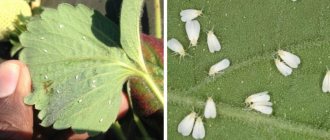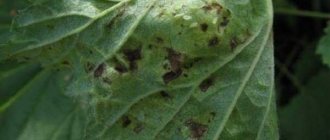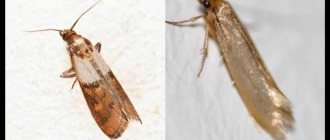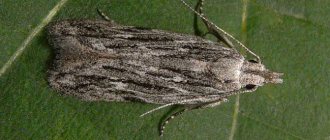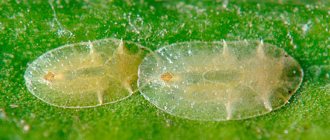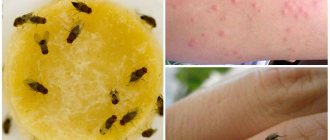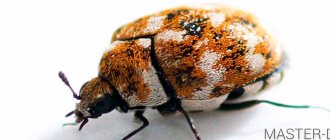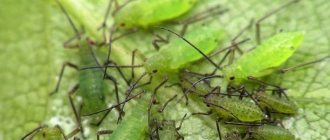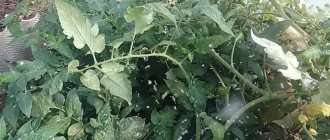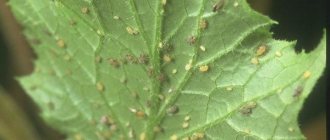Growing cucumbers is a troublesome business. The culture is very demanding in terms of temperature and humidity, and is often attacked by insects. Midges on cucumbers are the most common pests that can cause significant damage to the plant and thereby reduce productivity. Midges mean a variety of small flying insects, and methods of combating each species are different.
Whitefly and why it is dangerous
Another name for whitefly is white midge. Among gardeners it has the nickname “white death”. Neither street nor greenhouse plantings are immune from this scourge. The pest can enter the greenhouse from the street; the conditions there are very favorable - the appropriate humidity and temperature are very popular with whiteflies and contribute to their active reproduction. In open ground there is a very high risk of re-emergence of insects, which can fly from infected plantings even to other areas.
The whitefly is considered the most dangerous cucumber pest. It lays its larvae on the back side of the leaf, its offspring are large, so in a short time it can literally infest all the bushes and destroy them. The danger lies in the fact that the insect feeds on plant sap. And in such large numbers, the parasites extremely quickly deplete the bush, after which it dies.
Recognizing a whitefly is quite simple. This insect looks like a moth. Its wings are white and its body is white and yellow. The size of the pest is not too large - only 3 mm, and its larvae reach a length of 0.3 mm. Externally, their colony resembles small yellowish scales. As soon as they are born from eggs, they immediately move on to their meal and stick to the leaf, drinking all the juices from it.
Life cycle of a whitefly
When they gain strength, pupae form. During this period, any treatments have minimal impact on them. Next, an adult whitefly emerges from the pupa. It flies to other plants, affecting increasingly larger areas.
The complexity of the treatments lies in the fact that the eggs have low susceptibility to the agents used against them.
Methods of pest control in open ground also include chemicals. In a short time they show excellent results. But they can only be used until the cucumbers bloom. It is better not to treat greenhouse cucumbers with chemicals.
To avoid the appearance of whiteflies, the fight against it must begin long before the pest appears.
What types of midges are there?
First, let's figure out what kind of pests these are. And in order to make it easier for you to identify the insects that attacked your favorite flower, we suggest conditionally classifying them according to a very simple and striking feature - color. Most often, black or white midges are found on indoor plants.
White midges
These are usually whiteflies. There are quite a few types of whiteflies, but houseplants are most often attacked by b. tobacco, b. greenhouse and b. citrus. They look like snow-white or slightly yellowish tiny moths. The adults (adults) do not cause harm, but the larvae cause great damage by gnawing the lower part of the leaf.
Whiteflies on a citrus plant leaf
In addition to the cloud of insects that appears when you touch the pot or the plant itself, honeydew can be seen on the underside of the leaf blade. These are sticky, sugary white specks that are waste products of whiteflies. If you do not get rid of the pest in time, then a sooty fungus will begin to develop on the leaves - a faithful “comrade” of honeydew.
In addition to whiteflies, you may notice so-called soil midges. They do not fly, but they jump very actively. These are springtails. There are many varieties of them in nature, but most often found in indoor plants are six-legged ones of white or cream color. Otherwise, they are often called fools, but from a scientific point of view this is not entirely true, since real fools live in puddles, swamps and ponds, feeding on mosses, lichens and simple fungi. “Our” pest is the closest relative of the fool. It looks like a tiny (about 2 mm in length) caterpillar with a short mustache.
springtail
In a normal agricultural regime, a certain amount of springtails is always present in the soil of a houseplant, but they behave unnoticed and do not cause harm. With a “successful” combination of circumstances, they can simply multiply in a flurry, and then something will have to be done about it.
Black midges
Small black midges on house flowers are called sciarids, otherwise known as fungus gnats. Their length varies from 0.5 to 3 mm. Just like whiteflies, the adults of these insects do not harm plants or people, but their larvae make their way into the ground and feed on organic debris and fungi growing on them, thereby compacting the soil. When mass reproduction occurs, pests begin to use plant roots as food. As a result, infected green pets develop poorly and have a wilted appearance. The most common reason for the proliferation of black midges is fertilizing potted plants with damp, sleepy tea leaves, banana peels and similar organic waste.
Sciarida close up
The sciarid should not be confused with another midge that is very common in the summer-autumn period - the Drosophila. Otherwise, it is also called the fruit midge, since it needs the rotting pulp of fruits or vegetables to feed. If you remove all such products from free access, there will soon be no more fruit flies. By the way, these insects do not harm either plants or people, so the discomfort from their presence is only psychological.
Drosophila needs fruit
Consequences of whitefly damage to cucumbers
You can detect a whitefly only by carefully examining the bush, paying special attention to the back of the leaves - this is where the pest prefers to lay its larvae.
Infected bushes can be recognized by some obvious external signs that become noticeable with a quick glance at the plantings:
- leaves and stems are covered with a sticky coating over the entire surface;
- the leaf plate is deformed, curls, withers;
- greenish or yellowish spots appear on the surface of the leaves without clear boundaries;
- larvae appear on the reverse side of the leaf;
- the fruits stop filling and growing;
- when you shake a bush, a swarm of flies flies up from it;
- the plant turns black due to the appearance of sooty fungus.
If at least one of the above signs is observed on your cucumbers, you must immediately begin processing the plantings before it is too late.
Due to the fact that the parasite sucks the juice out of the plants, they begin to slow down their growth, little nutrients are supplied, dehydration occurs, the fruits do not grow, the leaves curl and fall off. As a result, you can lose the entire harvest.
In addition, the whitefly carries various diseases on itself. It often causes chlorosis, yellow mosaic, leaf curl and necrosis. In the place where the parasite stuck to the leaf, chlorophyll can no longer be formed; this area becomes vulnerable to various pathogenic organisms.
Mining flies
Leaf miners are also often called midges. The insects got their name from their feeding habits. The length of adult individuals does not exceed 2 mm. The color is variable and depends on the species. The female pierces the foliage with her ovipositor and lays eggs. After a few days, larvae emerge from them and gnaw through white passages called mines. After the food resource is exhausted, the young individual moves to the next leaf.
The female lives about 7 days. During this time, she manages to lay up to 400 eggs.
Insect activity begins in May and June. In case of serious infestations, plant growth deteriorates and leaves die off. How to deal with leafminer on cucumbers:
- colorful sticky traps are used to prevent the invasion of dangerous parasites;
- damaged leaves must be removed;
- surviving plants are treated twice with insecticides; Before flowering, you can apply Aktar, during the fruiting period - Vertimek.
Only regular inspection of seedlings, timely care and identification of pests will help preserve the cucumber crop.
How to deal with whitefly on cucumbers in a greenhouse
If a whitefly appears on cucumbers in a greenhouse, it is extremely undesirable to treat the plantings with chemicals, so gardeners use biological or folk remedies or mechanically remove the pest from the bushes.
Sticky tapes can be placed inside the structure so that adults flying inside stick to them. You can buy such Velcro at a hardware store, or you can make it yourself.
- Take several pieces of thick cardboard, plastic or plywood measuring 15x15 cm.
- Paint the blanks blue or yellow.
- Prepare honey, rosin, Vaseline and castor oil in equal proportions.
- Dissolve rosin in a water bath, then add all other ingredients.
- Stir the mixture, let it cool and apply to the workpieces.
- Place the finished Velcro along the entire perimeter of the greenhouse at different distances from the bushes. Pay special attention to the area near doors and windows.
Whiteflies can ignore conventional fly baits; they most readily flock to bright spots. As soon as the sticky layer on the workpiece dries, it must be removed and a fresh compound applied. To catch adult insects and prevent them from breeding, you need to thoroughly shake the bushes several times a day. Fumigators and mosquito repellent plates can be used as a preventive measure. During their operation, it is necessary to tightly close the doors and windows in the greenhouse.
When larvae are discovered, some gardeners begin to wash them off the leaves. But when they fall into the ground along with drops of the solution, they do not die, but grow up safely, again moving to the bush. Some particularly desperate gardeners even use a vacuum cleaner to suck up the pests. But this often leads to serious damage to the vegetative parts of the plantings.
Insect activity decreases at air temperatures below +10 °C, but as soon as it gets warmer, they will return to their usual way of life, but cucumbers are unlikely to survive such changes.
Traps: 2 ways to get rid of whiteflies on cucumbers
Simple traps help catch adults, which helps reduce their population in the area. You can make them yourself from scrap materials:
- A small plastic bottle needs to be painted bright yellow or blue, a sticky mixture of Vaseline and laundry soap should be made and the entire surface of the bottle should be covered with it. Such traps are suspended under the roof of the greenhouse at a short distance from the leaves of the plants. This measure will attract more insects.
- Take a red or yellow light bulb; if you don’t have one, then paint a regular one in the appropriate color. Connect it to electricity and place it in a small wooden box - it will serve as a lampshade. Hang an improvised lamp under the roof of the greenhouse or on a support near the garden bed, and place a wide container of water under it. Insects that fly into the light will receive burns from the hot bulb and fall into the water.
Reference. In a greenhouse, using special traps, you can destroy up to 80% of all adult whiteflies, especially if all the bushes are periodically shaken.
11 folk recipes for whiteflies on cucumbers (table)
The table below shows the main recipes for folk remedies that help fight whiteflies.
| Component | Methods of preparation and use |
| Tobacco | Tobacco sticks are used to process greenhouses. The doors and windows of the structure must be tightly closed, after which the checker is set on fire. Work should be carried out only in a protective suit, respirator and gloves. It will be possible to open the greenhouse no earlier than after 5 hours. Cucumbers can be treated with tobacco infusion made from tobacco from 10 cigarettes and 1 liter of boiling water. The solution is infused for about 5 days and topped up to a volume of 2.5 liters, after which it is filtered. Re-treatment is recommended every 3-5 days. |
| Laundry or tar soap | To prevent the insect from laying its larvae on the leaf, it is wiped on both sides with a solution of laundry or tar soap diluted in water in a ratio of 1:6. For better dissolution, it is recommended to first grate the soap on a fine grater. Usually, two treatments with an interval of 1 week are enough to prevent the appearance of pests. The same composition can be sprayed on the bush itself and the soil around it. |
| Vinegar essence | Plants are sprayed with 70% vinegar diluted in water at the rate of 1 tbsp of the substance per 1 liter of water. The procedure is repeated daily until the insects are completely destroyed. |
| Sugar solution | A sugar solution prepared at the rate of 250 g per 1 liter of water is sprayed onto the leaf blades affected by the pest. They are covered with a thin film, which must be carefully washed off after about 5 days. If the first treatment does not give the desired results, it must be repeated after 7 days. |
| Garlic | For every liter of water you need to take 1 good clove of garlic. It is finely chopped or passed through a press and filled with water. The solution should sit in a darkened room for a day, after which it should be used to spray the plantings every 5 days. |
| Yarrow | To prepare herbal infusion, yarrow is crushed and used at the rate of 100 g per 1 liter. The grass is poured with water and left for 3 days, stirring occasionally. This treatment is carried out once every 7 days. |
| Dandelion | Leaves and roots in an amount of 100 g each are finely chopped and filled with water (2 l). The solution should sit in a dark place for at least 4 days. After this, it is filtered, and the resulting composition is treated three times with an interval of 5 days by spraying. |
| Potassium permanganate | 3 g of crystals are poured with water (10 l), stirred until completely dissolved and the bed is watered. To prevent the appearance of the pest, weekly treatment is sufficient. |
| Benzyl bezonate | Add 60 ml of benzyl benzonate to 1 liter of water, stir and spray the plantings weekly. |
| Lemon | Lemon peels in the amount of 150 g are poured with water (2 l) and left to infuse for 2 days. After time, 40 g of pre-grated laundry soap are added to the solution. The composition is used for mechanical processing of sheet plates. |
| Solution based on turpentine oil (turpentine) | To prepare the solution you will need: 30 g of laundry soap, 30 ml of camphor oil, 25 g of dry yeast, 50 ml of turpentine, 10 ml of eucalyptus tincture, 1 tbsp. ammonia solution (ammonia). All components are mixed together and diluted with water in an amount of 5 liters. For a large area of plant damage, treatment is carried out 3 times with an interval of approximately 5 days. |
Natural enemies of whiteflies
Whiteflies have natural enemies in the wild that control the growth of the insect population. These include ladybugs and lacewings. They are attracted to garden flowers, especially marigolds, which can be planted close to the beds. But such a preventive measure does not give quick results, because there is no guarantee that ladybugs will settle en masse on the site.
Encarzia
On an industrial scale or during a whitefly invasion over a large area, it is recommended to use encarsia. You can buy them in large specialized stores. The number of individuals depends on how many whiteflies are in your area. In case of severe infestation, there should be one encarsia for every 15 larvae. They are released into the greenhouse a couple of weeks before planting so that this miniature wasp can destroy all enemies. By the way, this insect can smell a beetle larva at a distance of 20 meters.
The only difficulty that beneficial insects face is the villi on cucumber leaves, due to which it is not always possible to reach the larvae.
Macrolophus bug
Another enemy of pests is the polyphagous macrolophus bug. Most often it is used in greenhouses and greenhouses. It helps fight not only whiteflies, but also aphids, spider mites and thrips.
Plants
Ageratum
Another effective way to overcome the parasite is to divert its attention to a more attractive plant.
More than cucumbers, whiteflies love ageratum flowers and American weed. But they not only attract insects, but also have a sterilizing effect on them. If an adult pest drinks such juice, it will no longer be able to lay eggs and give birth to offspring. These plants can be planted close to the cucumbers, but not in the beds themselves, but in separate pots.
6 biological preparations for whiteflies on cucumbers
Biological preparations help fight whiteflies in large numbers of the pest, when folk remedies do not give the desired results. The table below describes the most effective of them.
| Name | Characteristic | Mode of application |
| Aktofit | The active ingredient of the drug is aversectin. It enters the body of whiteflies along with the juice and paralyzes the nervous system of the pests. Actofit is produced in the form of a dark brown or yellowish liquid; in stores you can buy a packaged drug or take a large canister or bottle at once. Effectively fights against whiteflies that attack greenhouse plantings of cucumbers, eggplants and tomatoes. It affects not only adults, but also larvae with eggs. | 6 ml of the drug is diluted in water to a concentration of 0.6%. Treatment is carried out twice at intervals of a week. The product works especially effectively if the treatment is carried out using fine sprays, for example, through a cold fog installation. The waiting period is 2 days. |
| Bitoxibacillin | The main active component of this intestinal pesticide is the bacterial strain Bacillus thuringiensis var. thuringiensis. The substance has a powdery structure and is sold in metered packages weighing 100, 50, 25 or 10 g. You can buy large packages weighing 10 or 20 kg. Bitoxibacillin, getting inside the insect, leads to the penetration of the alkaline filling of the intestine into the body cavity. This process ends in septicemia, resulting in the death of the whiteflies. | Spraying of bushes is carried out at the moment when insects begin to emerge from the larvae. Usually, only two sprayings with an interval of 5-6 days help get rid of the pest. The drug is diluted at the rate of 100 g per 10 liters of liquid. You can start collecting fruits only after 5 days. |
| Akarin (Agravertine) | The main component of the drug is Avertin N. It has a detrimental effect on the nervous system of insects, blocking the process of transmission of nerve impulses. The main advantage of Akarin is that insects do not develop resistance to the drug. It is effective in treating plantings not only against whiteflies, but also against mites and nematodes. | Processing is carried out during the growing season of cucumbers. The solution is prepared at the rate of 16 ml of the drug per 2 liters of water. This amount is quite enough to spray 1 sq.m. landing The total number of treatments is 3 times. You can harvest in 2 days. |
| Verticillin | The product has a liquid formula and a specific composition, which includes mycelium and spores of the entomopathogenic fungus Verticillium lecanii. The drug is sold in liquid form, packaged in bottles of 5, 1 or 0.5 liters. Verticillin is effective in controlling whiteflies at different stages of their development, except for the pupal stage - during this period the insect is not susceptible to treatment with the drug. | The solution is prepared by mixing 100 ml of the substance and 10 liters of water. Treatment is carried out at least 4 times with an interval of 10-12 days, so as not to miss the stage of larvae or eggs. When spraying, special attention should be paid to the back side of the leaf plate, where pests most often lay their future babies. If there are a lot of whiteflies, then it is necessary to make the solution more concentrated. To do this, dissolve from 200 to 500 ml of Verticillin in the same amount of water, and spraying is carried out weekly. |
| Fitoverm | The main active ingredient of the drug is aversectin C, which is a mixture of waste products of the fungus Streptomyces avermitilis. They have a paralyzing effect on the pest’s body; insect death occurs within 24 hours after treatment. | To prepare a solution for 1 liter of water, take 10 ml of the drug. Spraying is carried out every 1-3 weeks, regardless of whether cucumbers are growing in a greenhouse or outside. The frequency of repetitions depends on the extent of the infection. For 10 square meters of planting, about 1 liter of ready-made solution is enough. This insecticide is good because it is not addictive to insects, so it can be safely used several times throughout the season without losing its effectiveness. Complete dissolution of the components occurs within 48 hours, which makes it possible to use the product several days before the start of harvesting. |
| Biotlin | This insecticide comes in two types: Biotlin VRK - 20% imidacloprid concentrate in 1.5, 3 ml ampoules or 9 ml bottle; Biotlin BAU is a 10% imidacloprid concentrate, available in a 0.7 liter bottle equipped with a special convenient sprayer. The components of the drug easily enter the vascular system of the plant and are distributed throughout all its vegetative parts along with the juice. The pest, drinking it, receives a lethal dose of a substance that causes complete paralysis. Then convulsions occur and the pest dies. | During the period of active growth, cucumber is sprayed. To prepare a solution, Biotlin VRK is diluted at the rate of 5 ml per 10 liters of water. For 10 sq. m of beds, 3 liters of the prepared mixture is enough. Biotlin BAU is sold ready-made; a quantity of 0.7 liters is enough to spray 7 sq.m. beds. One treatment per season is enough, the harvest can be harvested after 3 days. |
If you follow all the instructions in the instructions, then biological preparations will not harm your cucumbers even during the period of active fruiting. Spraying should be carried out in the evening or morning hours, when sun activity is minimal. The leaves need to be thoroughly processed on both sides, paying special attention to their lower part. Do not forget to water the soil in the garden bed with insecticides while processing the plants; insects that have fallen from the bush may also be present there.
Preventive measures
To prevent the appearance of whiteflies on cucumbers in a greenhouse, a number of rules should be followed:
- Use traps. A bright surface will attract insects, and a sticky surface will prevent them from escaping.
- Experienced gardeners recommend using the “Bud” product for prevention.
- Carefully inspect the seedlings before planting in the ground. Purchase seedlings only from trusted manufacturers. Check the leaves before purchasing.
- After harvesting, carefully dig up the soil and remove all plant debris and debris.
- Treat the soil with bleach or copper sulfate. Fumigate the greenhouse with tobacco smoke. Treat the frames with Bordeaux mixture.
- Freeze the greenhouse in winter: open it for 1-2 days when the temperature drops below -12...-15 °C. In such conditions, insects die.
- Do not plant plants very densely and avoid extreme heat and humidity in the greenhouse. You can stretch a gauze mesh over the windows in the greenhouse.
Don’t be lazy to carry out prevention, and then the whitefly will not be scary for your cucumbers.
Forget about whiteflies in your area! An easy solution to your whitefly problem.
Features of the fight against whitefly on cucumbers in open ground
Processing cucumbers in open ground is carried out using the same methods as in a greenhouse. The only difference is that when planting outdoors, the range of means used expands - chemicals can be used there. They are characterized by high speed of action and efficiency. Chemicals destroy whiteflies even in large numbers. Some of them help destroy insects at the egg and larval stages.
11 chemical remedies for whiteflies on cucumbers
When traditional and biological drugs do not give the desired result, we have to resort to heavy artillery - the use of chemicals. We have listed the most effective and safest of them in the table below.
| Name | Characteristic | Mode of application |
| Aktara | The active component of the drug is thiamethoxam at a concentration of 250 g/kg or 240 g/l. Aktar has both direct and indirect effects on pests. | For spraying, 2 g of the substance is diluted in 10 liters of water, and for irrigation, its amount is doubled. Treatment should be carried out until the flowers appear once per season. |
| Aktellik | The drug belongs to the organophosphorus insecticides. The active ingredient is pirimiphos-methyl, its dosage is 500 g/l. | To prepare a solution, 3-4 ml of the substance are diluted in 1 liter of water. Depending on the scale of infection, for every 100 sq.m. 5 to 15 liters of the finished solution are consumed. Spraying is carried out twice with an interval of 5-7 days. The effect of one treatment lasts up to 2 weeks. If necessary, you can re-spray. |
| Alatar | The drug has two main active ingredients – malathion and cypermethrin. The composition is supplemented with antioxidants, surfactants, solvent and stabilizer. You can purchase the product in the form of a solution (50 ml bottle) or concentrate (5 ml ampoule). | Processing of cucumbers should be carried out no later than 20 days before the start of harvest. Consumption for 100 sq.m of plants is 4 liters of working preparation. To prepare it you will need 5 ml of Alatar. |
| Arrivo | The active ingredient of the product is cypermethrin. It gets inside the bush and spreads with the juice along the leaves and stems. Pests, having tasted the poison, die within half an hour due to paralysis. The drug is sold in concentrated form in small ampoules of 1.5 ml. | The contents of one ampoule are diluted in 10 liters of water. The effect lasts from 10 to 14 days. |
| Bona Forte | The active ingredient of the drug is natural pyrethrum. The solution is available in ready-made form. The bottle is equipped with a sprayer. A significant advantage of the chemical is the absence of addiction on the part of whiteflies. In addition, Bona Forte does not accumulate in plants and soil, thereby causing no harm to the environment or humans. | The product is used for spraying cucumber plantings. It must be sprayed from a distance of at least 30 cm to the leaves. Paying special attention to the reverse side of the sheet. If insects are also present in the garden bed, the soil on it must also be treated. |
| Decis | This chemical has a contact-intestinal effect. It is produced in three types: Decis Profi - granules for dissolution in containers of 6 kg or in bags of 1 g, Decis Expert - concentrated emulsion in volumes of 2 ml, 100 ml, 1 or 5 l, Decis Lux is an emulsion with an improved formula, packaged in 1 or 5 liter containers, 5 ml ampoules. | The working solution is prepared at the rate of 0.35 g of product per 5 liters of water. This amount is enough to spray 100 sq.m of plantings. Treatment is carried out before flowering during the period of active growth. |
| Inta-Vir | This drug belongs to the category of peritroids, which in their formula repeat natural insecticides. The active ingredient is cypermethrin. Inta-Vir is available in two forms: white tablets for dissolution in water in the amount of 8 pcs. packaged, powder weighing 8 g in each sachet. | No more than 3 treatments can be carried out per season. To prepare the solution, each tablet is diluted in 10 liters of water. |
| Iskra M | The active ingredient of the product is malathion (it is also found in the drug Karbofos). It remains in the plant for a long time, so you need to start processing at least 2 weeks before harvesting the cucumbers. | Prepare a working solution: 5 ml per 5 liters of water. Next, 1 liter of working solution is sprayed per 10 sq.m. |
| Confidor | The drug belongs to the class of neonicotinoids, the active substance is imidacloprid at a dosage of 70%. Confidor is presented by the manufacturer in the form of water-dispersible granules with a mild odor, brown color. You can purchase the product in containers of different weights - 1 g, 5 g, 400 g. | Treatment is carried out once after a colony of whiteflies is detected on the plantings. To prepare the solution, only 3.5 g of the drug is enough, this amount is enough to treat 100 sq.m. When spraying, the same amount of area will require from 10 to 30 liters of working solution. |
| Talstar (Bifenthrin) | The main component of the drug is bifenthrin. The drug is available only in the form of a concentrated emulsion. | Effectiveness after treatment remains for 2-3 weeks, which is important to consider when planning harvest. For every liter of water, add 0.6 ml of concentrate. |
| Tanrek | The drug is available in the form of a water-soluble concentrate. The active ingredient is imidacloprid. For large-scale plantings, the manufacturer offers a 1 liter package, and for small areas a container of 10 or 50 ml or a 1.5 ml ampoule is sufficient. | To prepare the solution, 5 ml of the drug is dissolved in 10 liters of water. Treatment is carried out once, the duration of action is 4 weeks. |
When working with chemicals, you need to take into account the fact that they cannot be stored in diluted form; they must be used immediately after preparation. Those products that require repeated treatment must be used at intervals of at least 5 days.
Spraying is carried out only during the period of vegetative growth; chemicals are destructive for flowers. Information about how much time should pass from the last treatment until the flowers appear and harvest is always indicated on the product packaging.
Spraying of cucumbers is carried out early in the morning or in the evening after solar activity decreases. Pay close attention to the weather forecast. In order for the result to be as effective as possible and last a long time, there should be no rain in the next three days after carrying out the work to destroy insects. If possible, not only the cucumber plantings are processed, but also the plants adjacent to them, if they do not yet have flowers and fruits, and the soil is also watered in case there are insect larvae there.
You cannot use the same product more often than the period specified by the manufacturer. Whiteflies develop resistance to active substances, and the effectiveness of treatments decreases. Therefore, all drugs used must be alternated.
Once flowers bloom or fruits appear on cucumbers, chemicals can no longer be used. During this period, you can use biological or folk remedies to control pests.
Important! Be sure to protect your face and hands during processing. The solution should not be able to get on the skin or mucous membranes. It is better to dispose of clothing and gloves after spraying.
What are midges
The phrase “midges in cucumbers” often refers to small pests with wings that settle in plantings and destroy them. Midges do not always represent one type of insect; sometimes there are several pests at once.
These insects appear not only in adult plants, but also in seedlings. For them, the time of year or the type of plant has practically no meaning. The colony is growing rapidly. The most common species is the white midge or whitefly. The larvae of this pest are especially dangerous for the plant; they penetrate the soil and spoil the roots of the cucumber.
There are also black midges. It is difficult to fight it; strong remedies are needed. Typically, midges appear when the ground is waterlogged, especially in cold weather. In hot weather, the soil dries quickly. The plant requires a lot of water.
When it gets colder, you don’t need to water the cucumbers so much. If the soil is waterlogged, it will become favorable for the spread of larvae. Often, cucumber pests are found in purchased soil, however, it is almost impossible to detect them right away.
There is no universal method of protection against midges, but it is possible to choose a product for each type. Now many manufacturers offer special broad-spectrum drugs for treatment and prevention.
It is easier to avoid pests than to deal with them later.
If you are going to plant cucumbers on your site using seedlings, prevention must be carried out at the stage of nurturing the sprouts.
Timely loosened soil, suitable fertilizers and proper watering are half the success.
If midges do appear in your seedlings, there are several popular ways to combat them:
- Watering plants with a solution of manganese, which will delay infection of plants and soil;
- A solution of lemon juice with liquid soap;
- Also, to combat midges, tobacco or garlic is placed in the soil.
These are safe products for both humans and plants, which are excellent at repelling midges. Sometimes it is possible to cope with insects only with the help of purchased products.
It is important to choose a composition that will not harm cucumbers. Read the instructions carefully and act strictly in accordance with them!
If the larvae reproduce too actively, the diseased plant must be isolated from healthy ones. The soil should also not be left in place or reused, because the pest can spread to other plants.
Parasite recognition
If midges appear on the stems, this is the very first sign of the development of the disease. The small butterfly is called a whitefly. It is characterized by one feature - gathering in small groups under the leaves. Midge larvae concentrate in the same place. Every day there are more and more parasites on cucumbers.
In parallel with the disease, chlorosis develops. It is a mosaic lesion of yellow leaves. Sooty fungus is often observed. Black spots indicate its presence. The leaves of cucumbers, which are parasitized by the midge pest, gradually turn yellow and wither, and the ovaries fall off.
In order to timely identify the whitefly and begin to fight it, you need to carefully monitor the seedlings. Butterflies tend to reproduce quickly. Thus, midges move to other plants. A farmer could lose his entire crop because of a small insect.
Spider mite
Spider mites mainly grow in greenhouses and greenhouses, but are also found on cucumbers in open ground
If cobwebs appear on your plants, pay close attention; most likely it is a mite.
The insect lives under a leaf, in the shade, although it loves the heat. The tick has a red color with a green tint. One female spider mite lays about 150 eggs per season, and if you do not fight this insect, the plant will die, because. these pests will suck all the juices from the leaves and flowers, drying out the sprouts.
To prevent spider mites, plant dill, parsley or carrots in the same bed with cucumbers. Ladybugs love to live on the plants listed above and they feed on mites. Also, the mite does not like moisture, and abundant watering for cucumbers only brings benefits.
If spider mites have already infested your cucumber beds, the plants can be treated with compounds that are harmless to humans and lethal to pests:
Treatment of cucumbers with chemical compounds is possible only in the early stages of plant growth; the rest of the time, such spraying is simply dangerous because the poisons will not have time to get out of the fruits.
How to rid garden beds of pests
It is necessary to take urgent action to save bushes from a harmful insect at the first symptoms of damage. The further the process goes, the more difficult it will be to do this. Parasites can be quickly destroyed only with modern insecticides. Such drugs as “Karbofos”, “Bud”, “Verticillin”, “Iskra” are suitable for this purpose, and in advanced cases it is worth using “Aktara” or “Detis”. But the use of poison on vegetables is fraught with negative consequences in the form of deterioration of health. Some toxic elements accumulate in the soil.
Harvesting from such an area is unsafe. Veterinary products based on fipronil – “Bars”, etc. – are considered less toxic. If you don’t want to use chemical solutions in your garden beds, you can trust traditional methods. Laundry soap, garlic, tobacco, etc. give a good effect. They are diluted in the required proportions and sprayed on the plantings. You can apply the emulsion with a sponge. The soap is first crushed and then dissolved in warm water. This technique is especially good in cases where the whiteflies have not yet had time to lay eggs. To prepare garlic tincture, take a couple of cloves of garlic per 1 liter of boiled water. The resulting mixture is kept for a day in a dark place, filtered and applied to the leaves. This method requires at least three treatments.
Signs of infection of cucumber bushes
In order not to miss the moment of parasite infestation, you need to regularly inspect cucumber bushes growing in the greenhouse and outside. The first sign of a problem will be the presence of small gray insects. These are midge larvae that usually collect on the underside of leaves.
Adults are small white butterflies. If there are only a few of them yet, you can try to collect insects by hand. The butterflies lay a large number of transparent eggs, from which new midges hatch in just a few days. As they grow, they feed more and more intensively, drawing out the last strength from the vegetable crop. And then they stop eating, having reached the pupal stage. Carefully inspect the leaves. First, white dots and spots appear on them. Gradually the tops turn yellow and finally wither.
Prevention
It is better to prevent the development of pests, then look for effective methods of combating them. Thanks to simple preventive measures, you can protect cucumbers from aphids. But how to get rid of this pest from your area forever, and what products should be used is indicated here.
The following recommendations should be followed:
- It is necessary to systematically loosen the soil, eliminating weeds. It is because of the weeds that aphids arise and move to vegetable crops.
- Attract ladybugs to the garden, for which aphids are excellent food. To do this, plant leaf mustard near the cucumbers. Ladybug is a natural helper against aphids.
- Eliminate ant colonies using chemical insecticides or folk remedies.
- Avoid planting cucumbers too thickly.
- Water the cucumbers 2 times per season with a solution of laundry soap.
The video shows ways to prevent and control black aphids:
Black aphids are an insidious pest that causes great damage to the yield of various vegetable crops, including cucumbers. To combat insects, you can use both chemical and folk remedies. Each of them is effective in its own way. When choosing them, you need to focus on the number of insects. If there is a massive lesion, then home remedies will not cope with it. Find out how to get rid of aphids on raspberries here.
Soap solution
This product helps a person in any situation. A solution is prepared from soap, which is diluted with water. It should be at room temperature. At the same time, the ratio is maintained at 1:6.
To make it more convenient, the soap is first crushed. This can be done using a knife or grater. After this, it is combined with water until completely dissolved. Then it is poured into a spray bottle and not only the green part of the cucumbers is treated, but also the ground. As a result of treatment, insects disappear from the plant in the shortest possible time.
Why do cucumbers rot?
Growing cucumbers indoors is not an easy task; you have to constantly maintain a certain microclimate, control the composition and condition of the soil, limit the growth of vines, and carry out preventive treatments. Only if you carry out a set of agrotechnical measures can you count on a bountiful harvest. In open beds everything is a little simpler.
Attention! Cucumbers bred specifically for growing in greenhouses and hotbeds can also rot if you miss some detail, for example, systematically watering them with cold water.
In open ground, it is possible to avoid rotting of cucumbers even in unfavorable weather, but only if you change the place for the crop and choose the right predecessors (onions, cruciferous crops, legumes and nightshade crops). Greenhouse conditions greatly complicate crop rotation. An annual, complete replacement of the fertile soil layer, in which fungal spores and larvae of harmful insects accumulate, is required. The main reasons for the development of rot:
- temperature violation;
- improper watering;
- unregulated air humidity;
- excessive or insufficient nutrition;
- lack of ventilation;
- cold drafts;
- crowdedness;
- ignoring disinfection.
The infection can be introduced into a greenhouse or garden beds on shoes and gardening tools; the source of infection is the soil in which the seedlings grew, as well as seeds. The spores are carried by aphids and whiteflies. Problems arise with neglected plants or due to improper harvesting. Old canes, overgrown greens and yellowed leaves are removed. Cucumbers are grown only on a trellis or twine, without allowing the ovaries to come into contact with the soil. Cucumbers are cut or torn off carefully, without leaving mechanical damage and always together with part of the stalk.
Slugs
During rainy, cloudy periods or in shaded, damp places under the cucumber vine, slugs breed en masse. These slow and, at first glance, completely defenseless creatures with great appetite eat the greens of cucumbers and eat the pulp of their fruits.
Night pest
They lay eggs in the soil on the eve of winter. In the spring, young individuals hatch from them, and after a couple of months they begin to eat the plants. Moreover, they do this only at night, and when the first rays of sunlight appear, they hide in secluded damp places until the evening. These mollusks feel especially good in a greenhouse, where high humidity is constantly maintained and there is no direct sunlight.
Control measures:
- Slugs are removed mainly by hand. Since they come out of hiding only in the dark, it is best to destroy them in the evening. You can walk around at night with a flashlight and collect the specimens you come across, or you can make your task a little easier and create a special shelter-trap where they will hide from the sun, and then simply collect them.
- Spray the plants with an aqueous infusion of hot capsicum. This liquid will not harm cucumbers, but slugs will not like it at all.
- An effective method is to treat the soil with slaked lime, ash, copper sulfate, and aqueous infusion of ammonia.
- It is necessary to monitor the bed, dig up the soil and regularly remove plant debris.
- We advise supporters of chemical drugs to use a product against slugs such as “Meta”.
